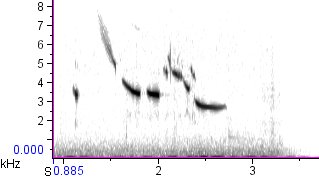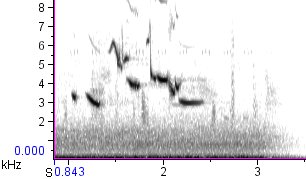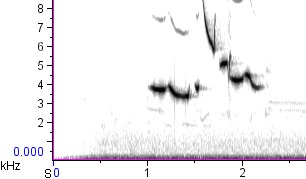“Lilian’s” Meadowlark songs
Introduction: The Literature
Interest in “Lilian’s” Meadowlark has spiked with the publication of Barker et al. (2008), which found significant genetic differences between Lilian’s and other “Eastern” Meadowlarks and recommended that Lilian’s be elevated to species status. Naturally, I keyed right in on the following quote:
Cassell (2002) found significant differences in the songs of Eastern and Lilian’s meadowlarks. However, given the learned nature of song in this group (Lanyon 1957), and the sharing of unlearned call notes between these forms (Lanyon 1957, 1962), the relevance of this observation with regard to species limits remains an open question.
A couple of months back I ordered Cassell’s (2002) thesis through interlibrary loan, to judge the evidence for myself. Overall, I found some aspects of the work very useful, but other aspects quite questionable. In particular, I have two complaints:
- In the introduction, Cassell makes the argument that differences in song, as an important isolating mechanism, are important to species boundaries. This is certainly true, but she makes the claim about meadowlarks and then supports it with discussion of nightjars, manakins and antbirds, none of which learn their songs. Meadowlarks not only learn their songs, but individuals have complex repertoires and populations show geographic dialectal differences. In addition, where their ranges overlap, Eastern and Western Meadowlarks defend territories against one another and will respond to playback of one another’s songs. Thus, on the one hand, the two species of meadowlarks recognize each other’s songs as similar enough to pose a territorial threat, a threat usually only posed by conspecifics. On the other hand, the two meadowlarks very rarely interbreed, and hybrids are infertile, so some kind of strong isolating mechanisms are clearly at work. The ways in which meadowlarks recognize songs must be much more complex than a simple evaluation of “same” or “different,” and so in my opinion the role that song plays in isolating these taxa needs more study.
- Cassell groups songs by number of “syllables” (2, 3, 4 or 5). She then compares, e.g., all two-syllabled songs of Lilian’s to all two-syllabled songs of Eastern. She doesn’t justify this methodology, and it seems to me that it makes an unwarranted assumption that all same-syllabled songs are homologous (that is, that songtypes with the same number of syllables share a closer evolutionary history with each other than with songtypes of a different number of syllables). To her credit, Cassell does cover her bases a little bit by adding a different analysis, comparing all long syllables (>0.20 sec) to all short syllables (<0.20 sec). But here again is a questionable assumption of homology. I would have found the whole argument more convincing if she had performed her analysis on the level of the whole song rather than the syllable.
Despite these issues, Cassell does convince me that Lilian’s songs average significantly lower in frequency than Eastern songs, in agreement with the descriptions in Sibley’s field guide. Cassell says:
In the field, the astute listener may recognize the primary song of S. m. lilianae by its overall lower pitch than that of S. m. magna.
So far, my experience indicates that this statement holds true in most (but not all) cases. Lilian’s song is frequently, but not always, low-pitched enough that it sounds like Western Meadowlark in tone quality (although the pattern of each song is still much more like Eastern than Western). In addition, it seems to me that Eastern Meadowlarks frequently end on a drawn-out, nearly monotone clear whistle, while Lilian’s tend to end on a whistle that is much more downslurred. There is a lot of overlap in the final note type, so caution is warranted, but I think the combination of terminal inflection and, especially, overall pitch (perceived largely as tone quality) should identify most Lilian’s Meadowlark songs.
Let’s Test This Hypothesis
A few weeks ago in Arizona I was able to record a few Lilian’s Meadowlark songs:

The first songtype, with its low pitch and its complex middle section, is particularly reminiscent of Western Meadowlark, but all three above seem fairly typical of Lilian’s. Note the downslurred endings.
For comparison, here are three typical songs of Eastern Meadowlark. Note the more “ringing” monotone endings (characterized by more horizontal lines on the spectrogram) and the relatively high pitch (lowest frequencies about 3 kHz, as opposed to 2 kHz for Lilian’s):

If all songs of both forms fit these patterns, field identification would be pretty easy, but sometimes the birds will throw you for a loop. Here’s a Lilian’s that sounds more like an Eastern on account of its high pitch and monotone ending:

And here’s a Eastern that sounds something like a Lilian’s on account of its relatively low pitch:

And, of course, not all Easterns have the ringing monotone ending:

For a little more ear practice, check out this wonderful repertoire remix of 19 different Lilian’s Meadowlark songtypes, all recorded by Andrew Spencer on 6/1/2009 from one individual bird in Eddy County, New Mexico. You’ll notice that about half the songtypes end in a ringing monotone whistle, which seems to be a slightly higher percentage than among the birds I recorded in Arizona.
To hear more Eastern Meadowlarks, check out Xeno-Canto’s collection. The Macaulay Library has plenty of Eastern Meadowlark songs also, and even a few Lilian’s.
Pop Quiz
All right, let’s find out how well this works. Here’s a remix of three meadowlark songs. Which ones are Eastern and which are Lilian’s? Leave your guesses in the comments field, and I’ll post the answers in a couple of days.

8 thoughts on ““Lilian’s” Meadowlark songs”
I would call the first one Lillian’s, and the second two Easterns. It Lillian’s can sometimes be high pitched, though, I’m not sure how you could rule on the middle one.
Great post! Looking forward to following this blog. -Willy
excellent post, and fantastic that you’ve put this blog together . . . look forward to many more posts . . .
Nathan,
This is going to be a tremendously educational blog. Thank you for starting it.
About the three meadowlark songs, I don’t know what to guess. The first one strikes me as having the low pitch of a Lilian’s but the strong flat ending of an Eastern. The second strikes me as having the high pitch of an Eastern but the downslurred ending of a Lilian’s. Based on pitch alone, the last one strikes me as an Eastern that isn’t much of a singer — but I have no idea whether an extraordinarily deficient Lilian’s might sound like this.
I’m not hedging bets there. Based on combinations of pitch and structure, I simply can’t decide about any of the three. I’m eager to hear and learn from the correct answers.
Incidentally, I’m intrigued by how different the dialect of your Colorado Eastern is from the dialect of my Pennsylvania Eastern.
–Paul
Hi Nathan,
This is fantastic, I’m glad to see you have entered the blogosphere. I’m very much looking forward to seeing many more posts from you here. I like your little Screaming Piha sonogram icon for your blog on the browser tab. 😉 And of course, who doesn’t love that Bobolink?
Best,
~Tayler
Kudos to Tayler (and, earlier, to Andrew Spencer) for recognizing my favicon, the little icon in the browser tab. It’s a spectrogram of one of the most distinctive bird sounds in the world, an iconic sound of Amazonia, the song of the Screaming Piha (Lipaugus vociferans). The spectrogram is just as striking as the sound. It also has to be one of the only spectrograms recognizable at a resolution of 16 x 16 pixels! You scream, pihas.
Answers to the sound quiz:
1) Lilian’s
2) Eastern
3) Eastern
Thus, Andrew was correct. I would say Paul was also correct, in that he rightly analyzed the important components of each song. My advice is to treat overall pitch (which will often be perceived as tone quality) as the most important identification criterion, with terminal note as a helpful secondary characteristic, but one that shows complete overlap.
Nathan,
Great start on the blog. I am looking forward to all your posts.
-Arch
Comments are closed.